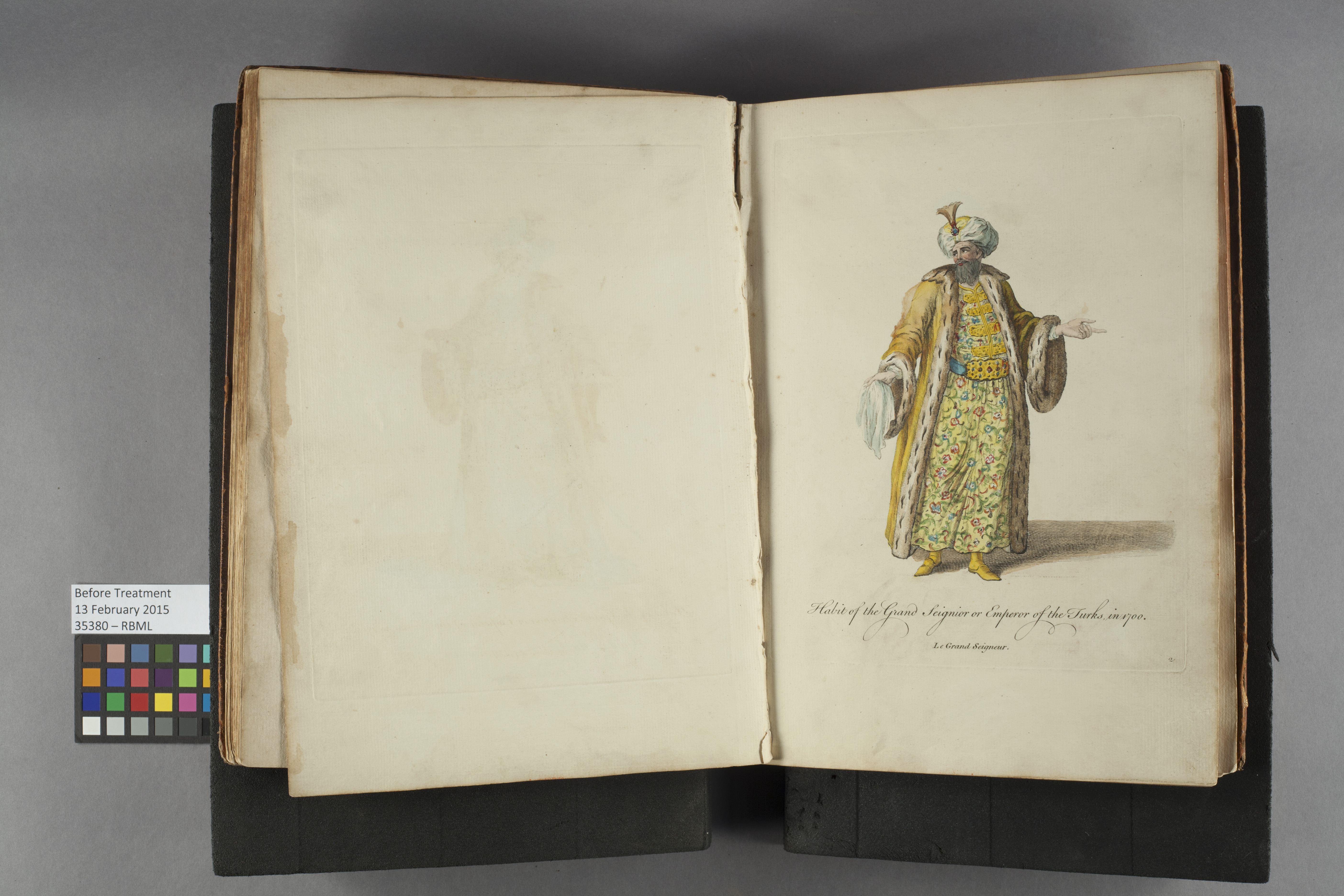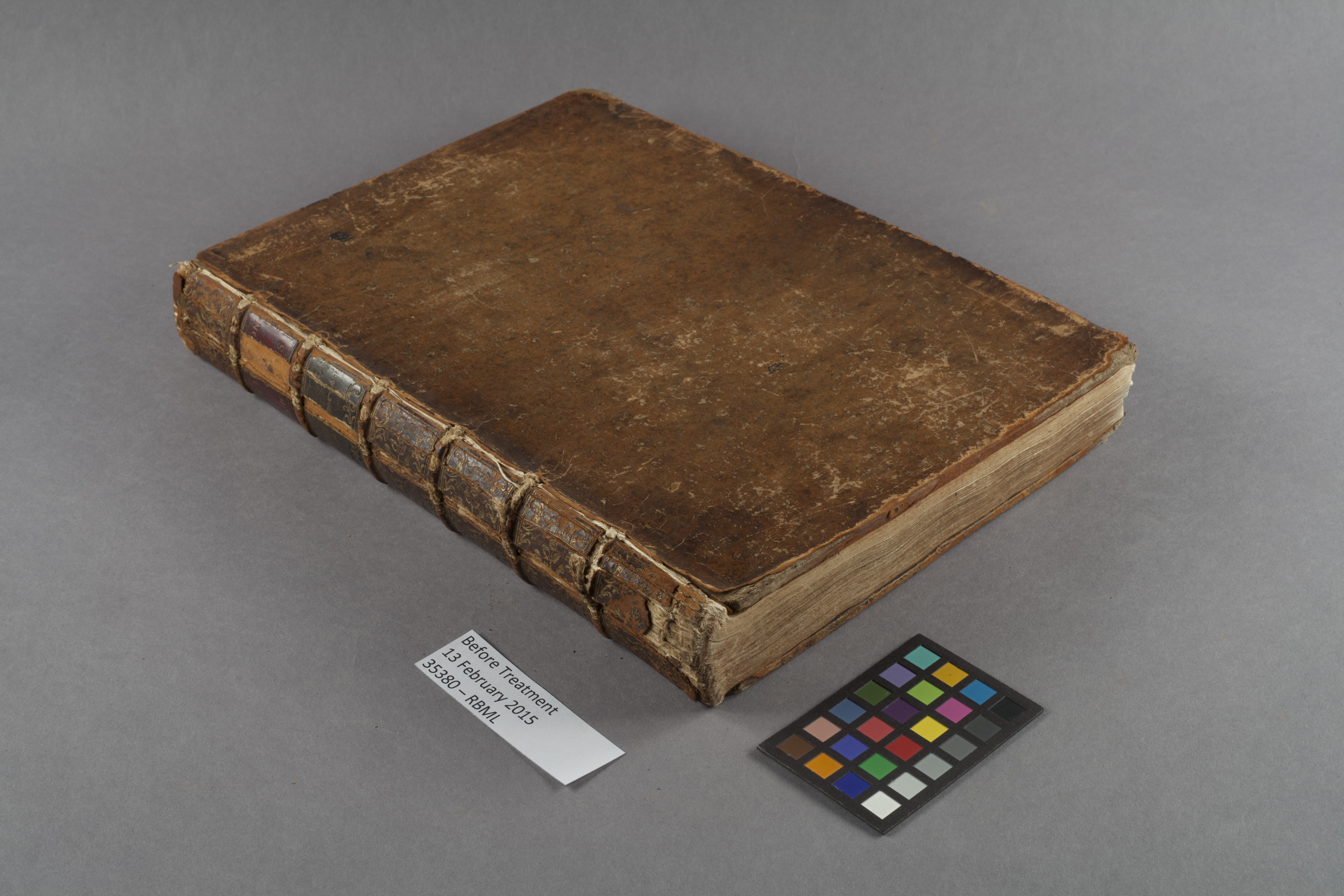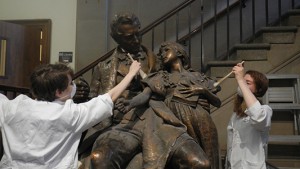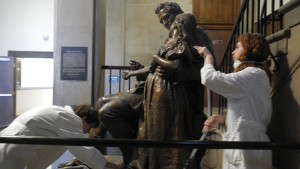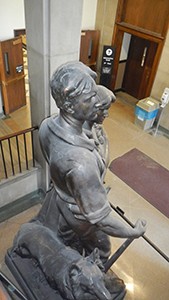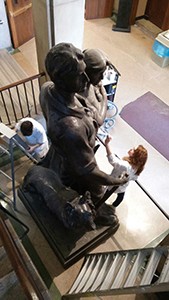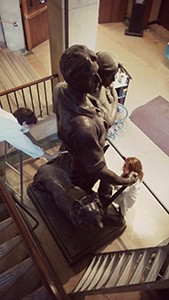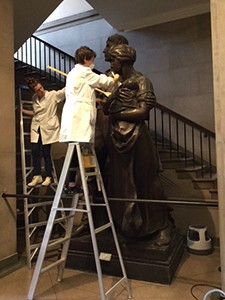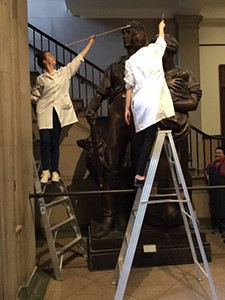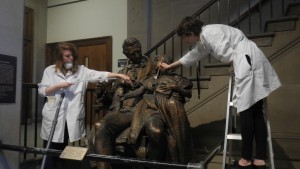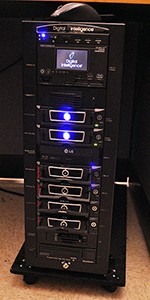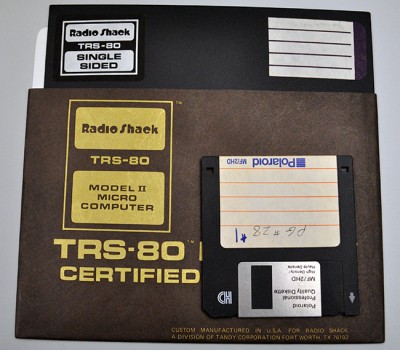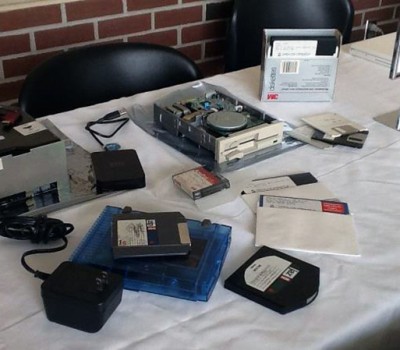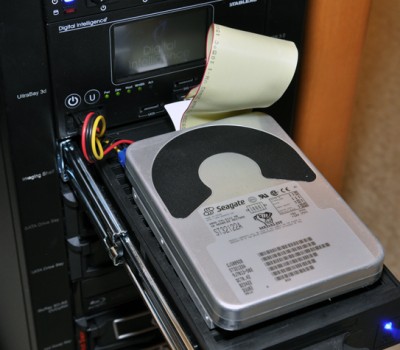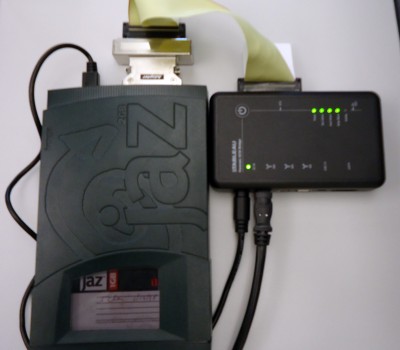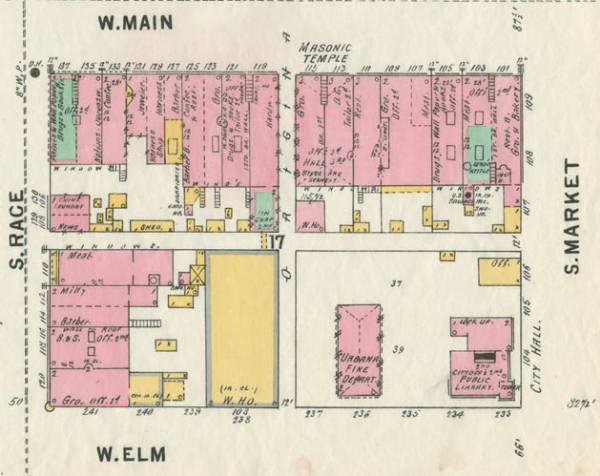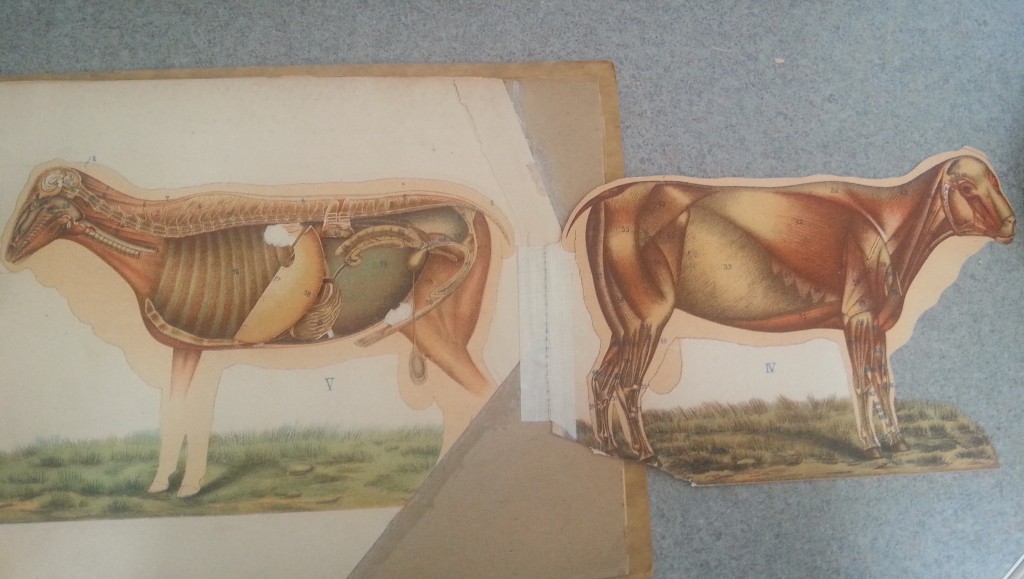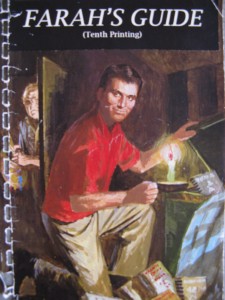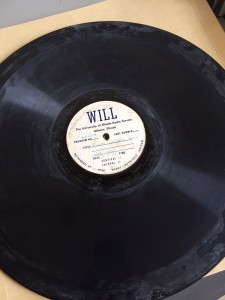What do we do in Preservation Services?
Preservation happens every day…
Please check out our daily blogs during Preservation Week.
Friday, May 1st, 2015 – BOOK CONSERVATION
Henry Hebert, Rare Book Conservator, shares some images and details about a treatment that he is currently working on for the next exhibit in RBML, titled “Poplin and Paper.”
This quarto-sized leather book was identified by curators at the Rare Book and Manuscript Library for inclusion in an upcoming exhibit. This is the first of a four-volume set titled, A Collection of the dresses of different nations, published by Thomas Jefferys in 1757. The textblock is composed of five letterpress printed sections (sewn through the fold) at the front and oversewn single plates at the back. The plates have all been colored by hand. The full calfskin binding has several condition issues that are common for bindings of this period: particularly powdery and broken leather at the joints and spine. The boards are still attached, but there is risk of the sewing supports breaking or further loss to the leather from opening the book. Additionally, the hand-colored plates are beginning to detach. Several different plates will be shown during the course of the exhibit in order to limit light exposure to the colored plates. In order for this volume to be displayed and used safely, I have been performing some repairs to address the leaf and board attachment problems. The pages were first carefully dry cleaned with eraser crumbs. The broken leather was gently lifted away from the textblock spine. Broken or weak sewing was reinforced with secondary sewing using linen thread and spine linings of strong Japanese paper were applied to create an appropriate book action and further strengthen the board attachment. I am currently in the process of re-backing the volume with dyed leather, that has been pared to fit underneath the original leather on the boards. When the new leather is adhered and dry, the original leather on the boards and spine will be adhered on top.
Thursday, April, 30th 2015 – COLLECTIONS CARE
Beyond Books: Caring for the heritage within our walls. Gillian Grossmann & Liz Lippoldt help to clean the statues of Daniel French’s Dr. Gallaudet and His First Deaf-Mute Pupil and Lorado Taft’s plaster cast of 1928 The Pioneers.
The Gallaudet Memorial (or Dr. Gallaudet and His First Deaf-Mute Pupil, 1888) is the plaster cast used to create the molds for the bronzes at the American School for the Deaf and Gallaudet University of Dr. Thomas Hopkins Gallaudet and Alice Cogswell.
The statues are located in a high traffic area and much dirt accumulates as people come in and out of the North & South exits of the Main Library building. They have required minor repair in the past. The Library undertakes their cleaning periodically.
Muriel (Mickie) Scheinman in her 1995 book: A Guide to Art at the University of Illinois (published by the University of Illinois Press) on page 58 states: “The plaster is more than just a means to produce a bronze statue; it is an artwork in its own right. Not only is it one of French’s significant early works, it is valuable too as it reveals the sculptor’s original conception of the piece before it was cast in bronze, especially in the variety of surface details the plaster allows. The sculpture is also innovative, as it presents a narrative portrait of an actual event without the customary allegorical implications.”
The plaster statues are convincingly finished to look like bronze. However they are fragile and great care is needed during their cleaning. We use handheld HEPA vacuums, microfiber cloths & hake brushes to clean them- unlike the more aggressive (and wet) approach of hosing down the dirt off its bronze casting counterparts!
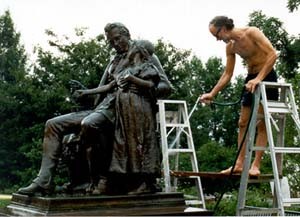
Cleaning the bronze version of
Dr. Gallaudet and His First Deaf-Mute Pupil, 1888
by Daniel Chester French
Restoration Efforts Underway for Historic Gallaudet Sculpture
Wednesday, April 29th, 2015 – BORN DIGITAL REFORMATTING
Remember that school paper you did that’s saved on a 5.25-inch floppy, or how awesome you thought zip disks were that could store SOOOOO much data (a meager 100 MB!)? Getting data off these types of materials is just a normal day at work for Tracy Popp, Digital Preservation Coordinator.
Born Digital Content Preservation provides content migration services to collection managers within the Library in order to capture data from obsolete physical digital media. Reformatting entails extracting data from the obsolete media and moving it to contemporary and managed digital storage.
We provide in-house reformatting services for a number of storage media (PC or Mac) including:
- 5.25″ floppy disks
- 3.5″ floppy disks
- Iomega ZIP and JAZ disks
- Optical Media: e.g. data CDs and DVDs
- Hard disk drives – internal and external; various types of interfaces
- Flash media including: jump\thumb drives, Compact Flash Card (CFC) – MicroDrive (MD) – Memory Stick Card (MSC)
Memory Stick Pro (MS Pro) – Smart Media Card (SMC) – xD Card (xD)
Secure Digital Card (SDC, SDHC and SDXC) – MicroSD – MultiMedia Card (MMC)
We utilize state-of-the-art tools for data recovery such as:
- Forensic Recovery of Evidence Device (FRED) workstation
- Forensic write-blockers for eSATA IDE/SATA, SCSI, USB, and media cards
Tuesday, April 28th, 2015– DIGITAL CONTENT CREATION (DCC)
Angela Waarala, Digital Collections Project Manager in Digital Content Creation, works to coordinate digitization of our Library’s collections, including our rare and unique materials:
DCC just finished a large digitization project of the Sanborn Fire Insurance Maps which are large-scale color and black and white lithographed street plans at a scale of 50 feet to one inch (1:600) on 21 by 25-inch sheets and bound into books. Another fun project currently underway is the digitization of the University of Illinois dissertations published before 1923, which when completed will offer digital access to all historic dissertations from the U of I.
Digital Content Creation offers the following services in support of digitization of library holdings:
- Digitization of maps, images, letters, scrapbooks, rare books, archival material, slides, microfiche, microfilm, filmstrips, and three dimensional objects.
- Full-book digitization
- Optical character recognition (OCR)
- PDF creation
- Patron requests
- Project planning and consultation
Monday, April 27th, 2015 – Brittle Books Reformatting & Media Preservation
BRITTLE BOOKS REFORMATTING
Molly Wayne, Reformatting Graduate Assistant, gives brittle books a second life:
“We are focused on providing preservation reformatting services brittle books and newspapers from our collections for which physical circulation is no longer possible. We work on identifying items for the brittle books workflow, obtaining replacements for missing or damaged pages, digitizing the material, and ingesting the content to the HathiTrust Digital Library or reformatting to microfilm. We see an assorted myriad of materials in our unit – here are a couple staff favorites:
Elizabeth Lippoldt, who wears many hats in Preservation, found this unusual look at the sheep’s anatomy in The sheep : its external structure & internal organs by A. Seyfferth ; revised and edited by G.T. Brown:
Caitlin Stamm, also working in Reformatting, found this item interesting:
Farah’s Guide by David Farah is a bibliography of Nancy Drew books and books written about Nancy Drew. Farah documents each book’s dust jacket design, price, ISBN, and printing, using his own system of symbols and acronyms. Farah’s Guide came to the preservation department because it needed a new cover; on the brittle books workflow, I help find replacement pages and covers for books that will be digitized or reformatted. Farah’s Guide needed a new cover so it could be rebound.
David Farah’s cover is a painting of him exploring an old attic, like Nancy Drew, and he captions the picture “Suddenly, David got the uneasy feeling he was being painted!!”. This copy is the tenth printing of his book, and Farah explains that “he did everything but grow the trees” in the production of his book. Most of the books that I work with don’t have very exciting covers, so to see Farah’s Guide was something different! I thought I was a Nancy Drew fan, but Farah has me beat.
MEDIA PRESERVATION
Andrew Crook, Media Preservation Graduate Assistant is listening to the past:
Transcription discs, which are direct cut lacquer coated discs on an aluminum, glass or cardboard base, were one of the more popular methods of recording in the era before the dominance of tape recording, with a significant number of radio broadcasts pre-1950s existing primarily in the form of transcription discs. For the past few years, the Preservation Services unit has been engaged in a project working with the University Archives in order to digitize the transcription discs created by local radio station WILL between the mid 1930s and the late 1950s, a collection that consists of almost 3,000 discs. As we can see, this project has been a bit of a race against time; due to their chemical composition, certain transcription discs will secrete palmetic acid which will, in turn, cause the disc to physically break down if left unattended. Furthermore, palmetic acid will regenerate even after it has been cleaned; for instance, the disc in this photo was cleaned and transferred a few months ago and is already showing signs of new palmetic acid! Fortunately, we’ve been working as hard as possible in order to ensure the longevity of these unique recordings by making high-quality digital surrogates of these discs, rehousing the originals and relocating them to environmental conditions that are less amenable to the creation of new palmetic acid. It’s been a long process, but we’ve made a lot of headway in ensuring that WILL’s early years remain accessible for the long-term!

